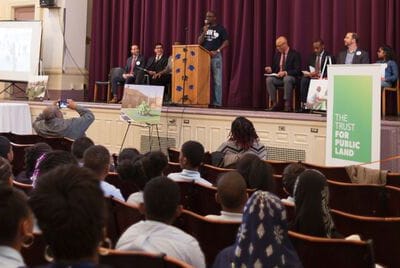
STEP 1: The Project Kickoff
Your project kickoff is an opportunity to build your team and agree on key items like the scope and target budget.
Creating a community schoolyard requires a strong team comprising school leaders, parents, teachers, students, and community members. Team members should bring diverse perspectives to the project. Ideally, you can identify team members from the following groups:
The project kickoff meeting is an important opportunity to gather your team together, make introductions, and decide how the project will move forward. Over the course of the meeting, your project team should come to an agreement on the following items:
STEP 2: Seek Early Approval from the School District, City, and Key Partners
Remember, your schoolyard is school district property, so you must receive written permission from the school district, and possibly from the municipal council (or equivalent), in order to advance the project. Some school districts are aware of the multiple benefits to community health and the educational setting that come from Community Schoolyards. These school districts may be able to provide additional support. In other cases, you may have to educate your school district about these benefits.
Important requests to bring before your school district at this phase include the following:

Getting early buy-in from your school district is a crucial step in making your community schoolyard a reality. © AMBER GARRETT
STEP 3: Create a Fundraising Packet
After you have approval of your concept, you are ready to prepare the fundraising packet. The fundraising packet will likely include the following:

LEFT: Including a “before” photo of the existing conditions can help demonstrate the project’s need to potential funders. Later, you can use these photos in before-and-after shots to show the transformation. © JULIETH RIVERA, TROY FARMER; RIGHT: Your fundraising packet will evolve as the project progresses.
Adding a rendering later in the process can help funders see the potential of the schoolyard and, when coupled with a current photo, can show the dramatic transformation that is possible. This community schoolyard project at Alexander Adaire School in Philadelphia was a community-led design process, implemented by The Trust for Public Land, School District of Philadelphia and Philadelphia Water Department. This concept design and the rendering were carried out by local community member, Ian Smith Design Group, working on a pro-bono basis.
© RENDERING BY KIRK FROMM
STEP 4: Fundraise
To ensure a full spectrum of support, try to secure funds for the design, construction, and stewardship of your schoolyard. Seek out public funding opportunities through federal, state, and local grants. Research private foundations that are active in your city and prepare a case for support. Your school district may be able to guide you to funding opportunities. Fundraising in partnership with other school nonprofits is a great strategy for widening support. Hold events such as dinners and auctions to support your schoolyard. You can also set up an online funding platform, such as GoFundMe or a Classy campaign. You may be able to fundraise in stages. For example, you may choose to fundraise for the participatory design and conceptual plan phase first, and later you can use the beautiful rendering to inspire partners and help attract construction funding. Have fun fundraising!



